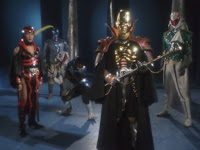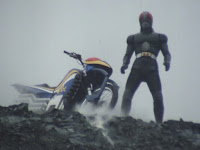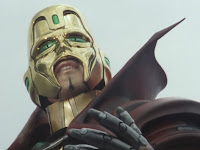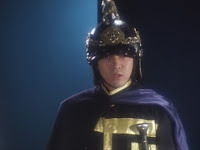While Kamen Rider franchise has always had some sense of continuity, direct sequels in a franchise that introduces a new hero each year is a rarity. But the popularity of Kamen Rider Black was that strong that in 1988 Kotaro Minami returned in a brand new form – Kamen Rider Black RX. The 47-episode series is notable for a number of other reasons as well, being both the final series in the franchise to have original author Shotaro Ishinomori involved but also the final entry in the Showa era period. Though the majority of Black RX may have technically aired at the beginning of the Heisei era, due to lengthy hiatus before the franchise returned in 2000 with Kamen Rider Kuuga it, along with movies Shin, ZO and J, are considered a much cleaner break.
It's been half a year since Kamen Rider Black's battle against Golgom, and Kotaro Minami has slowly begun to get his life together again. He's found a new home with the Sahara family, gotten a job as a helicopter pilot and even found love with photographer Reiko Shiratori. But evil looms over him once more, as envoys of the Crisis Empire – led by General Jark, arrive to prepare the Earth for a full-scale invasion. After having his ability to transform destroyed, Kotaro is thrown into outer space.
But on the brink of death, a miracle occurs. Kotaro's King Stone absorbs the sun's rays – returning to him to Earth in a brand-new body. With new powers, new allies and new forms to master, Kamen Rider Black RX resumes his fight against the Crisis Empire!
From the opening scene alone it's abundantly clear just how different Kamen Rider Black RX is from its predecessor. Whereas Black's powerful opening shows scenes of Kotaro's abduction, augmentation and escape from Golgom, Black RX kicks off with him smiling and laughing as he enjoys his new life as a helicopter pilot alongside his girlfriend. As the episode progresses the stark difference in tone is only further highlighted, with Kotaro joining in light-hearted shenanigans with the Sahara family before the Crisis Empire is introduced in scenes of slick 80s sci-fi that's a far cry from Black's murky cultism. It isn't hard to see why some Black fans would be turned off by the direction its sequel decided to take, but in many ways Black RX being the antithesis of Black is exactly what it needed to work as a sequel. It's no longer a story about a lone hero fighting back in the hopes of saving his best friend, it's one about that hero now trying to gain a semblance of a normal life. The Kotaro Minami we meet here might be a little different, but Tetsuro Kurata does a wonderful job of selling him as a Kotaro that's clearly trying to heal from his time as Black and the loss of Nobuhiko.
The result of this is a far more lighter series overall, with a far more optimistic outlook on Kamen Rider's particular brand of superheroism. But while it is certainly isn't afraid to have fun with its concepts ("You betrayed the children's expectations and dreams concerning flying squirrels" being one of the all-time great silly Kamen Rider lines), it still retains a serious side that can often be at odds with the rest of the show. It isn't hard to see how its approach is divisive among fans, with even Kurata himself having commented that he found the comedy in Black RX excessive. But its this idea of healing that really helps carry the show, and even if that wasn't the intention it nevertheless helps justify some of the choices that were made.
Kotaro's new outlook also brings with it a much wider supporting cast, many of whom eventually join him in his fight against the Crisis Empire. In addition to Reiko and the Sahara family there's also Joe the Haze – a martial artist who Kotaro frees from Crisis' brainwashing. Later in the series the group is also joined by Kyoko, an archer with the power to psychically manipulate groundwater – arguably one of the show's stranger elements. But it isn't just these older characters that assist Kotaro in his fight – Sahara children Shigeru and Hitomi also become privy to Kotaro's secret identity as they become intertwined in Crisis' schemes. While there are victim of the week characters as there are with any Kamen Rider series, Black RX's heavy use of recurring characters helps create a more closer-knit and lived in world that adds to the series' charm. As these characters choose to take a stand against the Crisis Empire, they become far more active elements of the story. Most significantly this completely dispels the notion of Kamen Rider as the lone hero. Though Crisis warn Kotaro that should his family and friends ever find out about his powers they would fear and reject him, each person he reveals his secret to only brings them closer together.
And if that isn't enough, the final act of the series famously sees the return of all ten previous Kamen Riders – marking a perfect end to the Showa era run of shows. With how closely linked this run of shows were previous Riders making reappearances isn't a rarity, but having them appear for a number of episodes really helps heighten the tension of the endgame. Their absence from Black also makes their appearance here that little more significant too, as though they're finally bringing everything together right at the very end. It's wonderful to see all ten Riders fighting alongside Black RX even if it's in costume only, and whilst each of them gets their moment to show off it's also careful not to take the spotlight away from both Black RX and his friends – they are very much the supporting characters in their show, but the reverence of these legacy characters is certainly not lost.
It isn't just the human aspect that's different about the series either, as Black RX shows off a Kamen Rider that’s very different to its predecessors. Partly due to its status as a sequel series, Toei looked to take the series in a direction to didn't stick to typical Kamen Rider elements – turning to other Toei franchises like Super Sentai and (more specifically) Metal Heroes for inspiration. These changes can be as seemingly minor as RX using weapons for finishing moves as opposed to a traditional Rider Kick, but altogether build a show that discards previous notions of what a Kamen Rider series should be. Some may see it more as Metal Heroes show than a Kamen Rider one (which makes sense given that Toei would push forward with Metal Heroes whilst Kamen Rider was off the air), but if anything Black RX is more indicative of what Kamen Rider would eventually become. From Kotaro's more upbeat disposition to RX's multiple forms, in some ways Black RX paved the way for the more varied franchise Kamen Rider has become in recent years. This is particularly interesting given that it's officially recognised as part of the Showa era, though the appearance of the ten legacy Riders in the final few episodes shows just how different of a Rider RX is compared to them.
But despite the similarities, the approach Black RX has to some of these aspects certainly isn't the same as modern day Kamen Rider. Form-changing is a far less laborious process, with each one serving a specific purpose and the switching between them instantaneous. While there was undoubtedly some element of merchandising to the whole thing (Acrobatter's alternate forms for example serve no real purpose, though could easily be further sate series sponsor Kawasaki), their introduction feels much less of an event – with both additional forms debuting in rapid succession in a single arc rather than spread across the series. That said, each one is given ample opportunity to make a strong impression. Black RX is an excellent all-rounder, clearly conveying the idea of reborn Black in its design whilst the Revolcane is both an iconic weapon and finishing attack. Robo Rider in comparison is a much slower and less mobile Rider (wonderfully conveyed though the three suit actors' robotic movements) but able to soak up hits like they're nothing. Finally Bio Rider is a first glimpse at just how powerful alternate Rider forms can be, utilising it's unique ability to transform into liquid in some rather creative ways. Though their earlier appearances are usually more centred around using a specific form to beat a specific monster, as the show progresses the fights become more creative in having RX quickly switch between them mid-battle. The three work together really well together, and are so distinct in their looks and approaches that they often feel like different Riders altogether as opposed to different forms.
But despite the similarities, the approach Black RX has to some of these aspects certainly isn't the same as modern day Kamen Rider. Form-changing is a far less laborious process, with each one serving a specific purpose and the switching between them instantaneous. While there was undoubtedly some element of merchandising to the whole thing (Acrobatter's alternate forms for example serve no real purpose, though could easily be further sate series sponsor Kawasaki), their introduction feels much less of an event – with both additional forms debuting in rapid succession in a single arc rather than spread across the series. That said, each one is given ample opportunity to make a strong impression. Black RX is an excellent all-rounder, clearly conveying the idea of reborn Black in its design whilst the Revolcane is both an iconic weapon and finishing attack. Robo Rider in comparison is a much slower and less mobile Rider (wonderfully conveyed though the three suit actors' robotic movements) but able to soak up hits like they're nothing. Finally Bio Rider is a first glimpse at just how powerful alternate Rider forms can be, utilising it's unique ability to transform into liquid in some rather creative ways. Though their earlier appearances are usually more centred around using a specific form to beat a specific monster, as the show progresses the fights become more creative in having RX quickly switch between them mid-battle. The three work together really well together, and are so distinct in their looks and approaches that they often feel like different Riders altogether as opposed to different forms.
The other big switch up in Black RX's arsenal comes from his vehicles, because of course this series is notable for being the first to add a car in addition to the usual motorcycle. But as shocking as this might have seemed at the time, in reality Rideron fits into both the series and the overall theme of Black RX really well. It maintains a good balance of using both Acrobatter (the reborn Battle Hopper from the original Black) and Rideron in equal amounts, but Rideron is significant because it plays into Kotaro's expanding circle of allies. With numerous side characters in addition to the usual victims of the week a bigger vehicle is necessary for Kotaro to get everyone out of trouble, but Rideron itself is also an important ally – sentient much in the same way Acrobatter is. Though this fact rarely has any story significant for either Rideron or Acrobatter, they nevertheless add to the strong support circle Kotaro has around him in this series.
Standing against Kotaro and his friends are the Crisis Empire, or more specifically an invasion party of some of its strongest soldiers. Led by the ruthless General Jark, these include marine captain Bosgun, mystic intelligence officer Maribaron, cybernetic biker Gatezone and fang captain Gedorian. Each of them represents a difference aspect of Crisis' forces, leading to a variety of different monster types across the series. Each of their designs are based on these designations too, giving the group good variety when it comes to visual appeal. On the other hand it could be argued that it means the Crisis Empire lacks cohesion in the way other villain groups do, particularly as the story plays fast and loose on just what the Crisis Empire is – they're pretty much aliens, mutants and interdimensional beings all rolled into one. While each of the captains respect General Jark and are able to work together, at the same time they're all seeking power of their own – leading to some interesting dynamics as they all gradually try to one up each other. This is only further complicated by the later arrival of Dasmader – an envoy of Emperor Crisis who's displeased with the group's lack of progress. Overall they're a really enjoyable villains thanks to both their dynamic and design variety, keeping Black RX interesting as you never know which one is going to take charge of an operation next.
Standing against Kotaro and his friends are the Crisis Empire, or more specifically an invasion party of some of its strongest soldiers. Led by the ruthless General Jark, these include marine captain Bosgun, mystic intelligence officer Maribaron, cybernetic biker Gatezone and fang captain Gedorian. Each of them represents a difference aspect of Crisis' forces, leading to a variety of different monster types across the series. Each of their designs are based on these designations too, giving the group good variety when it comes to visual appeal. On the other hand it could be argued that it means the Crisis Empire lacks cohesion in the way other villain groups do, particularly as the story plays fast and loose on just what the Crisis Empire is – they're pretty much aliens, mutants and interdimensional beings all rolled into one. While each of the captains respect General Jark and are able to work together, at the same time they're all seeking power of their own – leading to some interesting dynamics as they all gradually try to one up each other. This is only further complicated by the later arrival of Dasmader – an envoy of Emperor Crisis who's displeased with the group's lack of progress. Overall they're a really enjoyable villains thanks to both their dynamic and design variety, keeping Black RX interesting as you never know which one is going to take charge of an operation next.
While the Crisis Empire's plans of preparing the Earth for a mass-migration of its denizens is a simple enough motive to carry the villains through the show, it is somewhat let down by late-game complications that could have worked brilliantly had they been implemented much earlier. Whereas the majority of the show treats it like a standard invasion, it's later hinted that humanity's polluting of the Earth is what caused the Empire's need to migrate in this first place. It's so thinly handled that it could easily be played off as a last-minute ploy by the near-defeated Empire, but the notion of Crisis believing themselves to be fully justified in their actions could have made for a far more interesting dynamic between them and Kotaro. However the show chooses to play it, it was definitely a concept that deserved expansion beyond the finale of all places.
But even with new enemies to fight the evil of Golgom still haunts Kotaro, with Shadow Moon returning from the dead to fight once more. Given how the trauma of Nobuhiko's brainwashing and transformation is such a big part in shaping Kotaro as a character it's surprising how downplayed Shadow Moon's return is in the series, only featuring for two episodes rather than a designated mini-arc like so many of the show's other great moments. That said these episodes play an important part in tying Black RX to its predecessor, as well as a turning point for Kotaro when it comes to letting people join his fight against Crisis. With the episodes coming shortly after the introduction of Joe the Haze, Kotaro faces the dilemma of losing someone to evil once more. In being able to defeat Shadow Moon and put Nobuhiko properly to rest, Kotaro is finally able to move on and become the hero he is for the rest of the series. As one of the franchise's greatest villains it goes without saying that Shadow Moon's episodes are among RX's best, even if the portrayal is a little different.
Though perhaps not as ambitious as its predecessor, the direction Kamen Rider Black RX takes the story of Kotaro Minami is truly what makes this series special – turning it from one of tragedy and loss into one of healing. Its departure from the typical tropes of the Kamen Rider franchise act as a preview of just how malleable the concept can become, and together with one of the best opening themes of the franchise offers hours of solid superhero entertainment in the way only tokusatsu can deliver. Though Black RX sadly marked the end of the Showa era for Kamen Rider (at least as far as series are concerned anyway), it's nevertheless an enjoyable series that is often overlooked.


















3 comments:
Kamen Rider Black RX is way better than its American counterpart Saban's Masked (or as Sean Akizuki puts it, Mashed) Rider because of better acting, storyline and choreography fights. It's a shame there's no American counterpart of Dasmader. And Shotaro Ishinomori was angry at Saban because of the adaptation mishandling, I guess.
P.S. The correct spelling words are Nobuhiko Akizuki/Shadow Moon and Sahara Family.
This one I feel should’ve gotten a 3 instead of a 4. Not because I think it’s bad or anything but there’s allot of contradicting going on here as Kotaro barely feels like the same character he was in Black. You could argue it’s because of what he went through in Black, but the show gives no real answer nor any real hints to any sort of trauma. Keep in mind, this is a Showa series, sort of, in the late 80s. I don’t think that type of storytelling was really up to snuff until around the 2000s or anything by Toushiki Inoue, despite my mixed feelings on his writing. My biggest problem though, and this is more of a nitpick, I was SO disappointed we didn’t get to see the Black suit in the series at least one more time. And not I don’t count the 3D movie special, I mean him transforming into Black in the first episode to fight off the villains for a bit and THEN lose the suit. That way we get one last action scene with the thing before seeing just how much more of a threat the Crisis Empire is before Kotaro loses it, at the very least that way the suit could get a decent send off before switch to the Black RX suit. One other thing I should bring up, and this is a big SPOILER so onlookers read at you’re own risk (you have been warned) the ending it way too depressing. Seriously, not only does Kotaro have to kill Shadowmoon again, but literally the entire Sahara family dies. Like Jesus Toei, give the guy a break already. This just feels a bit too mean spirited and just leaves the show in too much of a depressing note. I still really like this show but man is it hard ti sit through at points.
Yeah I do completely agree about the ending point. It's completely uncalled for and doesn't fit with the tone of the rest of the show. It didn't spoil all the fun I'd had with it up until that point (and that's ultimately the reason I scored it the way I did), but I can totally see why that would be a breaking point for people.
Post a Comment